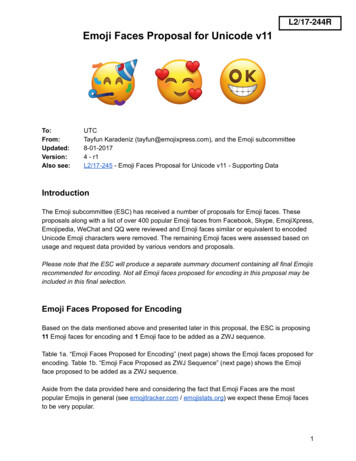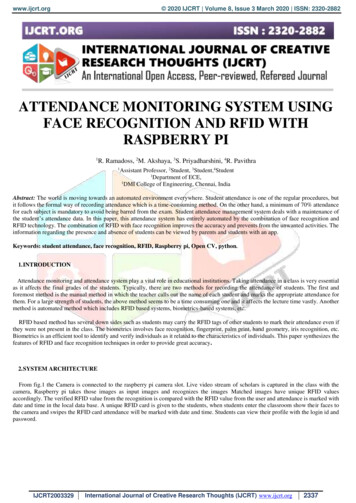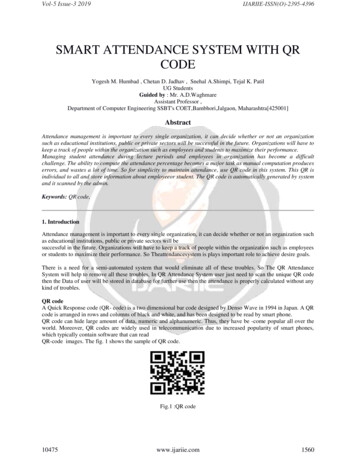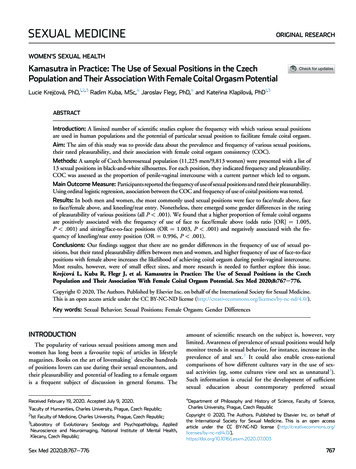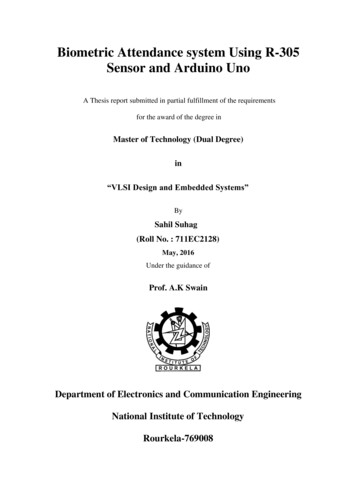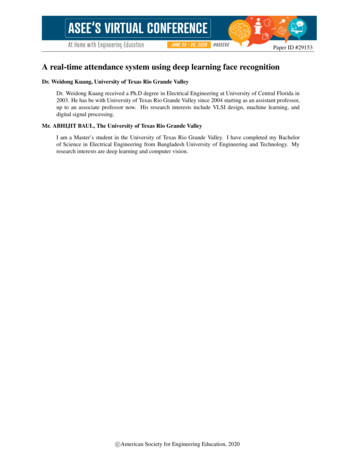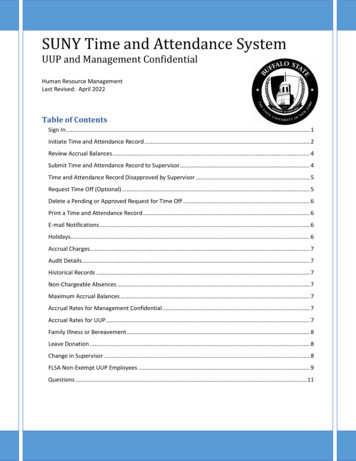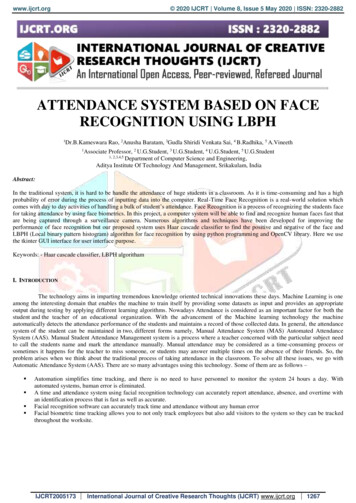
Transcription
www.ijcrt.org 2020 IJCRT Volume 8, Issue 5 May 2020 ISSN: 2320-2882ATTENDANCE SYSTEM BASED ON FACERECOGNITION USING LBPH1Dr.B.Kameswara Rao, 2Anusha Baratam, 3Gudla Shiridi Venkata Sai, 4 B.Radhika, 5 A.Vineeth1Associate Professor, 2 U.G.Student, 3 U.G.Student, 4 U.G.Student, 5 U.G.Student1, 2,3,4,5Department of Computer Science and Engineering,Aditya Institute Of Technology And Management, Srikakulam, IndiaAbstract:In the traditional system, it is hard to be handle the attendance of huge students in a classroom. As it is time-consuming and has a highprobability of error during the process of inputting data into the computer. Real-Time Face Recognition is a real-world solution whichcomes with day to day activities of handling a bulk of student’s attendance. Face Recognition is a process of recognizing the students facefor taking attendance by using face biometrics. In this project, a computer system will be able to find and recognize human faces fast thatare being captured through a surveillance camera. Numerous algorithms and techniques have been developed for improving theperformance of face recognition but our proposed system uses Haar cascade classifier to find the positive and negative of the face andLBPH (Local binary pattern histogram) algorithm for face recognition by using python programming and OpenCV library. Here we usethe tkinter GUI interface for user interface purpose.Keywords: - Haar cascade classifier, LBPH algorithamI. INTRODUCTIONThe technology aims in imparting tremendous knowledge oriented technical innovations these days. Machine Learning is oneamong the interesting domain that enables the machine to train itself by providing some datasets as input and provides an appropriateoutput during testing by applying different learning algorithms. Nowadays Attendance is considered as an important factor for both thestudent and the teacher of an educational organization. With the advancement of the Machine learning technology the machineautomatically detects the attendance performance of the students and maintains a record of those collected data. In general, the attendancesystem of the student can be maintained in two, different forms namely, Manual Attendance System (MAS) Automated AttendanceSystem (AAS). Manual Student Attendance Management system is a process where a teacher concerned with the particular subject needto call the students name and mark the attendance manually. Manual attendance may be considered as a time-consuming process orsometimes it happens for the teacher to miss someone, or students may answer multiple times on the absence of their friends. So, theproblem arises when we think about the traditional process of taking attendance in the classroom. To solve all these issues, we go withAutomatic Attendance System (AAS). There are so many advantages using this technology. Some of them are as follows – Automation simplifies time tracking, and there is no need to have personnel to monitor the system 24 hours a day. Withautomated systems, human error is eliminated.A time and attendance system using facial recognition technology can accurately report attendance, absence, and overtime withan identification process that is fast as well as accurate.Facial recognition software can accurately track time and attendance without any human errorFacial biometric time tracking allows you to not only track employees but also add visitors to the system so they can be trackedthroughout the worksite.IJCRT2005173International Journal of Creative Research Thoughts (IJCRT) www.ijcrt.org1267
www.ijcrt.org1.1 Drawbacks of various Attendance systems: 2020 IJCRT Volume 8, Issue 5 May 2020 ISSN: 2320-2882Types of the Attendance systemsDrawbackRFID-basedFraudulent usageFingerprint-basedTime consuming for students to wait and give theirattendanceIris-basedInvades the privacy of the userWireless-basedPoor performance if topography is badThere are two phases in Face Recognition Based Attendance System: 1.2 Face Detection:Face Detection is a method of detecting faces in the images. It is the first and essential step needed for face recognition. It mainly comesunder object detection like for example car in an image or any face in an image and can use in many areas such as security, bio-metrics,law enforcement, entertainment, personal safety, etc.1.3 Face Recognition:Face Recognition is a method of identifying or verifying a person from images and videos that are captured through a camera. Its Keyrole is to identify people in photos, video, or in real-time.II. LITERATURE SURVEYThere were many approaches used for dealing with disparity in images subject to illumination changes and these approacheswere implemented in object recognition systems and also by systems that were specific to faces. Some of the approaches as follows: A method for coping with such variations was using gray-level information to extract a face or an object from shading approach [1]. Themore reason gray scale representations are used for extracting descriptors instead of operating on color images directly and also grayscale simplifies the algorithm and reduces computational requirements. Here in our case, color is of limited benefit and introducingunnecessary information could increase the number of coaching data required to attain good performance [2]. Being an ill-posed problem,these proposed solutions assumed either the item shape and reluctance properties or the illumination conditions [3]. These assumptionsmade are too strict for general beholding, and so, it didn’t persuade be sufficient for face recognition.The second approach is the edge map [4] of the image which could be a useful object representation feature that's insensitive toillumination changes to certain event. Edge images might be used for recognition and to realize similar accuracy as gray levelpictures. The edge map information approach owns the advantage of feature-based approaches, like invariance to illumination and lowmemory requirement. It integrates the structural information with spatial information of a face image which can be done by groupingpixels of face edge map to line segments. After thinning the edge map, a polygonal line fitting process is applied to come back up withthe edge map of a face [5] [6] [7] There is one another approach through which the image disparities because of illumination differencesare handled; it's by employing a model of several images [8] of the identical face which is taken under various illuminationconditions. During this kind of approach, the pictures captured may be used as independent models or as a combined model-basedrecognition system [9] [10].Smart Attendance Monitoring System: A Face Recognition based Attendance System for Classroom Environment [11] proposed anattendance system that overcomes the problem of the manual method of existing system. It is face recognition method to take theattendance. The system even captures the facial expression lighting and pose of the person for taking attendance.Class Room Attendance System using the automatic face recognition System [12] a replacement approach a3D facial model introduced tospot a student's face recognition within a classroom, which can be used for the attendance system. Using these analytical researches willhelp to produce student's recognition in automated attendance system. It recognizes face from images or videos stream for record theirattendance to gauge their performance.RFID based attendance system is used to record attendance, need to place RFID [13]and ID card on the card reader based on the RFIDbased attendance to save the recorded attendance from the database and connect the system to the computer, here RS232 is used. Theproblem of fraudulent access is going to be rise from this method. For instance, someone like every hacker will authorize using ID cardand enters into the organization.IJCRT2005173International Journal of Creative Research Thoughts (IJCRT) www.ijcrt.org1268
www.ijcrt.orgIII. METHODOLOGY 2020 IJCRT Volume 8, Issue 5 May 2020 ISSN: 2320-2882Haar Cascade ClassifierLocal Binary Patterns HistogramThese two methodologies come under OpenCV. OpenCV comes with a trainer and as well as a detector. So, if you want to train yourclassifier for any object then you can use this classifier called Haar Cascade Classifier.3.1 Haar Cascade Classifier:Detecting objects with the help of Haar cascade classifiers is an effective method proposed by Paul Viola and Michael Jonesin their paper, "Rapid Object Detection using a Boosted Cascade of Simple Features" in 2001. Object Detection comes under machinelearning based approach where a cascade function is trained from lots of positive and negative images.Now what are these positive and negative images?A classifier (namely cascade of boosted classifiers working with haar like features) which is trained with many samples of a specificobject (i.e., a face or a car), called positive example. So, whatever you want to detect if you train your classifier with those kinds ofvalues. For example, if you want to detect face then you need to train your classifier with number of images which contain faces. So,these are called positive images which contain the object which you want to detect.Similarly, we want to train the classifier with negative images that means the images which doesn’t contain object that you want to detect.For example, if we want to detect the face then the image which doesn’t contain the face is called negative image. In the same way if theimage contains face or number of faces then it is called positive images.After a classifier is trained it can be applied to the region of interest in an input image and classifier outputs 1 if the region is likely toshow the object or 0 otherwise.Here we will work with face detection. Initially, in order to train the classifier, the cascade function needs a lot of positive images (imageswhich contains faces) and negative images (images without faces). Then we need to extract features from it. For this, we use Haarfeatures shown in the below image are used. They are just like our convolutional kernel. Each feature is claimed to be one value which isobtained by subtracting the sum of pixels under the white rectangle from the sum of pixels under the black rectangle.Now to calculate lots of features, all possible sizes and locations of each kernel are used. (Just imagine how much computation it needs?Even a 24x24 window results over 160000 features). In order to calculate each feature, we need to find the sum of the pixels under whiteand black rectangles. To get over from it, they introduced the integral image. Calculation depends upon the size of the image if How largeyour image, it reduces the calculations for a given pixel to an operation involving just four pixels. Nice, isn't it? It makes things superfast.But among all these features most of them are irrelevant that we calculated. For example, consider the image below. The top row showstwo good features. In the first feature it focuses on the region of the eyes which is commonly darker than the region of the nose andcheeks. When comes to the second feature it focuses on the property that the eyes are often darker than the bridge of the nose. But if it isapplied to cheeks or any other place is irrelevant that you can observe in the image. By using Adaboost we select the best features out of160000 features.IJCRT2005173International Journal of Creative Research Thoughts (IJCRT) www.ijcrt.org1269
www.ijcrt.org 2020 IJCRT Volume 8, Issue 5 May 2020 ISSN: 2320-2882In the same way, we have to apply each and every feature on all the training images. It finds the best threshold for each and every featurewhich will classify the faces to positive and negative. Obviously, there will be errors or misclassifications. We only select the featureswith minimum error rate because they are the features that most accurately classify the face and non-face images. (The process is not assimple as this. Each and every image is given an equal weight in the beginning. After each classification, there will be a change inweights in which weights of misclassified images are increased. Then the same process is done again. New error rates and new weightsare calculated. The process will be continued until the required accuracy or error rate is achieved or the required number of features isfound).The final classifier is obtained by weighted sum of these weak classifiers. It is then called weak classifier because it alone can't classifythe image, but together with others forms a strong classifier.3.2 Local Binary Patterns Histogram:Local Binary Patterns Histogram algorithm (LBPH) is for face recognition. It is based on local binary operator, and it is oneof the best performing textures descriptor. The need for facial recognition systems increasing day by day as per today's busy schedule.They are being used in entrance control, surveillance systems, smartphone unlocking etc. In this article, we will use LBPH to extractfeatures from an input test image and match them with the faces in system's database.Local Binary Patterns Histogram algorithm was proposed in 2006. It is based on local binary operator. It is widely used in facialrecognition due to its computational simplicity and discriminating power. The steps involved to achieve this are: creating datasets face acquisition feature extraction classification3.2.1 Steps involved in LBPH: Suppose consider an image which having dimensions N x M.For every region in an image we have to divide it into regions of same height and width resulting in m x m dimensionLocal binary operator is used for every region. The LBP operator is defined in window size of 3x3IJCRT2005173International Journal of Creative Research Thoughts (IJCRT) www.ijcrt.org1270
www.ijcrt.org 2020 IJCRT Volume 8, Issue 5 May 2020 ISSN: 2320-2882Here '(Xc,Yc)' considered as central pixel with intensity 'Ic'. And 'In' being considered as the intensity of the neighbor pixel It compares a pixel to its 8 closest pixels, by setting median pixel value as threshold. If the value of neighbor is greater than or equal to the central value it is set as 1 otherwise it is set as 0.Thus, we obtain a total of 8 binary values from the 8 neighbors.After combining these values, we get an 8 bit binary number which is translated to decimal number for our convenience.The obtained decimal number is said to be the pixel LBP value and its range is 0-255. After the generation of LBP value histogram for each region of the image is created by counting the number of similar LBPvalues in the region.After creation of histogram for each region all the histograms are merged to form a single histogram and this is known as featurevector of the image.Now we compare the histograms of the test image and the images in the database and then we return the image with the closesthistogram.We can use various kinds of approaches to compare the histograms (calculate the distance between two histograms), forexample: Euclidean distance, chi-square, absolute value, etc.The Euclidean distance is calculated by comparing the test image features with features stored within the dataset. The minimumdistance between test and original image gives the matching rate. As an output we get an ID of the image from the database if the test image is recognized. LBPH can recognize both side and front faces and it is not affected by illumination a variation which means that it is moreflexibleIJCRT2005173International Journal of Creative Research Thoughts (IJCRT) www.ijcrt.org1271
www.ijcrt.org3.2.2 Let us consider an example [14]:- 2020 IJCRT Volume 8, Issue 5 May 2020 ISSN: 2320-28823.3 System Flow Diagram:IJCRT2005173International Journal of Creative Research Thoughts (IJCRT) www.ijcrt.org1272
www.ijcrt.org 2020 IJCRT Volume 8, Issue 5 May 2020 ISSN: 2320-2882Step 1: First of all, it captures the input imageStep 2: After capturing the image it will preprocess the image and coverts the image into gray scale Image.Step 3: By using Haar Cascade Classifier face detection will be done and extracts features from the image and then stored in trained setdatabase.Step 4: Similarly face recognition is done by using Local Binary Patterns Histogram.Step 5: And then extracted features will be compared with the trained data set.Step 6: If it matches attendance will be updated in the attendance folder.Step 7: If not matches attendance will not be updated in the attendance folder.3.4 How our Proposed System works?When we run the program, a window is opened and asks for Enter Id and Enter Name. After entering respective name and idfields then we have to click Take Images button. By clicking the Take Images button, a camera of running computer is opened and itstarts taking image samples of person. This Id and Name is stored in Student Details folder and file name is saved as Student Details.csv.It takes 60 images as sample and stores them in Training Image folder. After completion it notifies that images saved. After taking imagesamples in order to train the image samples we have to click Train Image button. Now it takes few seconds to train the machine for theimages and creates a Trainner.yml file and stores them in TrainingImageLabel folder. Now all initial setups are done. After completion oftake images and Train images we have to click Track images button which is used to track the faces. If the face of particular student isrecognized by the camera then Id and Name of person is shown on Image. Press Q (or q) for quit this window. After coming out of it,attendance of particular person will be stored in Attendance folder as csv file with name, id, date and time and it is also available inwindow.IV. SAMPLE OUTPUT:1. Front viewIJCRT2005173International Journal of Creative Research Thoughts (IJCRT) www.ijcrt.org1273
www.ijcrt.org2. Captures image of particular student 2020 IJCRT Volume 8, Issue 5 May 2020 ISSN: 2320-28823. A notification message displayed like image saved for particular student with id and nameIJCRT2005173International Journal of Creative Research Thoughts (IJCRT) www.ijcrt.org1274
www.ijcrt.org 2020 IJCRT Volume 8, Issue 5 May 2020 ISSN: 2320-28824. Clicking on Train image button, it displays a notification message like “Image Trained”5. On clicking the track image button, it recognizes the face (which is already trained) and displays the name and id of the particularperson.IJCRT2005173International Journal of Creative Research Thoughts (IJCRT) www.ijcrt.org1275
www.ijcrt.org 2020 IJCRT Volume 8, Issue 5 May 2020 ISSN: 2320-28826. On clicking quit button, attendance is updated as shown in the attendance bar.7. Attendance of particular student is updated in the “Attendance folder”.V. CONCLUSION:We have implemented an attendance management system for student’s attendance. It helps to reduce time and effort, especially in thecase of large number of students marked attendance. The whole system is implemented in Python programming language. Facialrecognition techniques used for the purpose of the student attendance. And also, this record of student attendance can further be usedmainly in exam related issues like who are attending the exams and who are not attending. On this project, there is some further worksremained to do like installing the system in the classrooms. It can be constructed using a camera and computer.IJCRT2005173International Journal of Creative Research Thoughts (IJCRT) www.ijcrt.org1276
www.ijcrt.org 2020 IJCRT Volume 8, Issue 5 May 2020 ISSN: 2320-2882VI. REFERENCES:[1] B.K.P. Horn and M. Brooks, Seeing Shape from Shading. Cambridge, Mass.: MIT Press, 1989[2] Kanan C, Cottrell GW (2012) Color-to-Grayscale: Does the Method Matter in Image 029740[3] Grundland M, Dodgson N (2007) Decolorize: Fast, contrast enhancing, color to grayscale conversion. Pattern Recognition 40: 28912896.[4] F. Ibikunle, Agbetuvi F. and Ukpere G. “Face Recognition Using Line Edge Mapping Approach.” American Journal of Electrical andElectronic Engineering 1.3(2013): 52-59[5] T. Kanade, Computer Recognition of Human Faces. Basel and Stuttgart: Birkhauser Verlag 1997.[6] K. Wong, H. Law, and P. Tsang, “A System for Recognizing Human Faces,” Proc. ICASSP, pp. 1,6381,642, 1989.[7] V. Govindaraju, D.B. Sher, R. Srihari, and S.N. Srihari, “Locating Human Faces in Newspaper Photographs,” Proc. CVPR 89, pp.549-554; 1989[8] N. Dalal, B. Triggs “Histograms of oriented gradients for Human Detection”, IEEE Computer Society Conference on ComputerVision and Pattern Recognition, Vol. 1, 2005, pp. 886 – 893.[9] Modern Face Recognition with Deep learning. Website Reference: un-part-4modern-face-recognitionwith-deep- learning.[10] S.Edelman, D.Reisfeld, and Y. Yeshurun, “A System for Face Recognition that Learns from Examples,” Proc. European Conf.Computer Vision, S. Sandini, ed., pp. 787-791. Springer- Verlag, 1992.[11] Shubhobrata Bhattacharya, Gowtham Sandeep Nainala, Prosenjit Das and Aurobinda Routray, Smart Attendance Monitoring System: A Face Recognition based Attendance System for Classroom Environment, 2018 IEEE 18th International Conference on AdvancedLearning Technologies, pages 358-360,2018.[12] Abhishek Jha, "Class room attendance system using facial recognition system", The International Journal of Mathematics, Science,Technology and Management (ISSN : 2319-8125) Volume: 2,Issue: 3,2014.[13] T. Lim, S. Sim, and M. Mansor, "RFID based attendance system", Industrial Electronics Applications, 2009. ISIEA 2009. IEEESymposium on, volume: 2, pages 778-782, IEEE 2009.[14] w-lbph-works-90ec258c3d6bIJCRT2005173International Journal of Creative Research Thoughts (IJCRT) www.ijcrt.org1277
A time and attendance system using facial recognition technology can accurately report attendance, absence, and overtime with an identification process that is fast as well as accurate. . RFID based attendance system is used to record attendance, need to place RFID [13]and ID card on the card reader based on the RFID .
